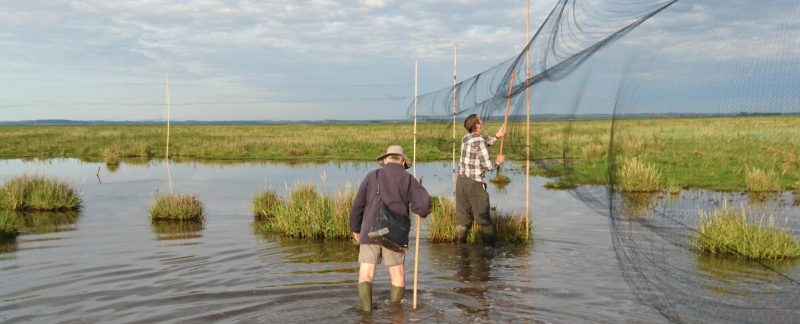Because waders feed in the intertidal area between high and low tide we are only able to catch them at or near high tide when their feeding grounds are covered and the birds are forced to concentrate into roosts close to the water’s edge, or if the tide is particularly high, on fields inland. The Wash is one of the largest estuaries in Britain, so at low tide they are thinly dispersed over large areas of soft, sticky mud hundreds of metres from the shore. The time and height of high tide is therefore the most important factor in determining when and where birds can be caught, which is why the trip reports contain so many references to them.
The tidal cycle on the Wash is such that tides which are the best height for catching occur in the morning and evening, which can mean an early start for a morning catch and a late finish for an evening catch.
The Group uses two methods of catching birds – cannon netting and mist netting.
Cannon netting
Cannon nets are used in daylight. The Group has a number of nets of different shapes and sizes for use in different circumstances. The net is set near where the birds are expected to be at high tide. Typically we would aim to have the net set at least two hours before high tide (often the night before if we are to get any sleep!).
The net is laid out in a line on the ground where we want to catch and projectiles (basically metal weights) are connected to ropes attached to the net. The projectiles are placed into cannons containing a small charge, which are buried in the ground behind the net, and connected via a cable to an observation point some distance away. For more descriptions see the Glossary page.
When the charge is set off the projectile is ejected from the cannon at high speed and carries the net out over the birds. It is possible to catch many hundreds of birds at the same time with cannon nets, although the average catch size is about 100.
Mist netting
Although the nets are made of a fine material with no background trees or shrubs they are easily seen and avoided by the birds in daylight, so mist netting has to be done at night. The nets are erected in a line (or sometimes an H, E or similar shape) over pools which the birds are expected to use at high tide and hang vertically between poles which are securely pegged and guyed to prevent them falling over.
Saltmarshes at night are potentially hazardous as there are a number of deep creeks – which can be fast flowing at some stages of the tidal cycle – and it is all too easy to lose one’s bearings on a dark night and be unable to find the way back to base, or fall in a creek. Hazards are therefore marked so they can be found in the dark, and no one is allowed on the marsh alone, so help is always on hand if someone has a problem.
The height of tide is even more important for mist netting than cannon netting. An unexpectedly high tide can leave the team waist deep in water – not fun in January when the water is cold! – and conversely an unexpectedly low tide may mean the birds remain on the tide edge hundreds of metres away with a catch that is small or non-existent.
Mist netting catches tend to have a wider range of species than cannon net catches – maybe 10 or more. While a typical catch would be in the order of 100 birds, on a good night in excess of 350 might be caught.
This article (PDF download – 164 kb) from the autumn 2015 edition of the BTO LifeCycle magazine, gives more information about mist netting coastal waders.

